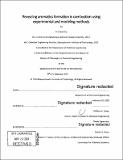Revealing aromatics formation in combustion using experimental and modeling methods
Author(s)
Chu, Te-Chun, Ph. D. Massachusetts Institute of Technology.
Download1292981488-MIT.pdf (30.52Mb)
Other Contributors
Massachusetts Institute of Technology. Department of Chemical Engineering.
Advisor
William H. Green.
Terms of use
Metadata
Show full item recordAbstract
Aromatic species have always been important in industry, but even increasingly so in recent years. Besides the large amount of aromatics produced as commodity chemicals, soot formation caused by polycyclic aromatic hydrocarbons (PAH) leads to serious clogging or pollution in the petrochemical industry. Therefore, understanding aromatics formation has been prioritized to improve the efficiency of desired chemical production processes. Advanced experimental techniques and detailed models help us draw a complete picture of aromatic chemistry. This thesis includes a modeling work for rich natural gas combustion where syngas, ethylene (C₂H₄), and acetylene (C₂H₄) are the valuable products, and aromatics are undesired byproducts. Through high-level quantum chemistry calculations performed in literature and trained into Reaction Mechanism Generator (RMG), aromatic chemistry was understood from a theoretical viewpoint and accurately predicted by the model. For example, Hydrogen-Abstraction-C₂H₄- Addition (HACA) was identified as the leading pathway of naphthalene formation (C₁₀H₈, one of' the simplest PAHs). To measure and validate critical aromatic kinetics in models, we designed and built a new compact quartz reactor to replace a stainless steel reactor in a unique apparatus combining laser absorbance spectroscopy (LAS) and time-of-flight mass spectrometry (TOF-MS). Reaction networks including phenyl radical (C₆H₄) + C₂H₄ and C₆H₅ + C₂H₄ (reactants of HACA) have been investigated for their kinetics and time-dependent product branching ratios. At various temperatures and pressures, the total rate constants of C₆H₅ + C₂H₄ were measured by LAS and direct product quantification of both networks was reported from TOF-MS measurements. Experimental measurements successfully validated detailed models built from ab initio calculations without fitting any kinetics parameters. Furthermore, the importance of HACA in developing three fused-benzene ring species was emphasized, and reactions of naphthyl radicals (C₁₀H₇) + C₂H₂ were investigated theoretically along with new pathways connecting networks of 1-C₁₀H₇ + C₂H₄ and 2-C₁₀H₇ + C₂H₄ . Pressure dependence of kinetics in this dissertation was considered due to the high temperature nature of natural gas combustion; therefore, the pressure effects in a natural gas pilot plant have been studied to apply chemistry learned from calculations or experiments to the real-world chemical industry. Overall, studies in this dissertation successfully investigate fundamental aromatic chemistry through experimental and theoretical approaches and connect them to natural gas combustion for future process development.
Description
Thesis: Ph. D., Massachusetts Institute of Technology, Department of Chemical Engineering, May, 2020 Cataloged from the official PDF of thesis. Includes bibliographical references (pages 249-262).
Date issued
2020Department
Massachusetts Institute of Technology. Department of Chemical EngineeringPublisher
Massachusetts Institute of Technology
Keywords
Chemical Engineering.